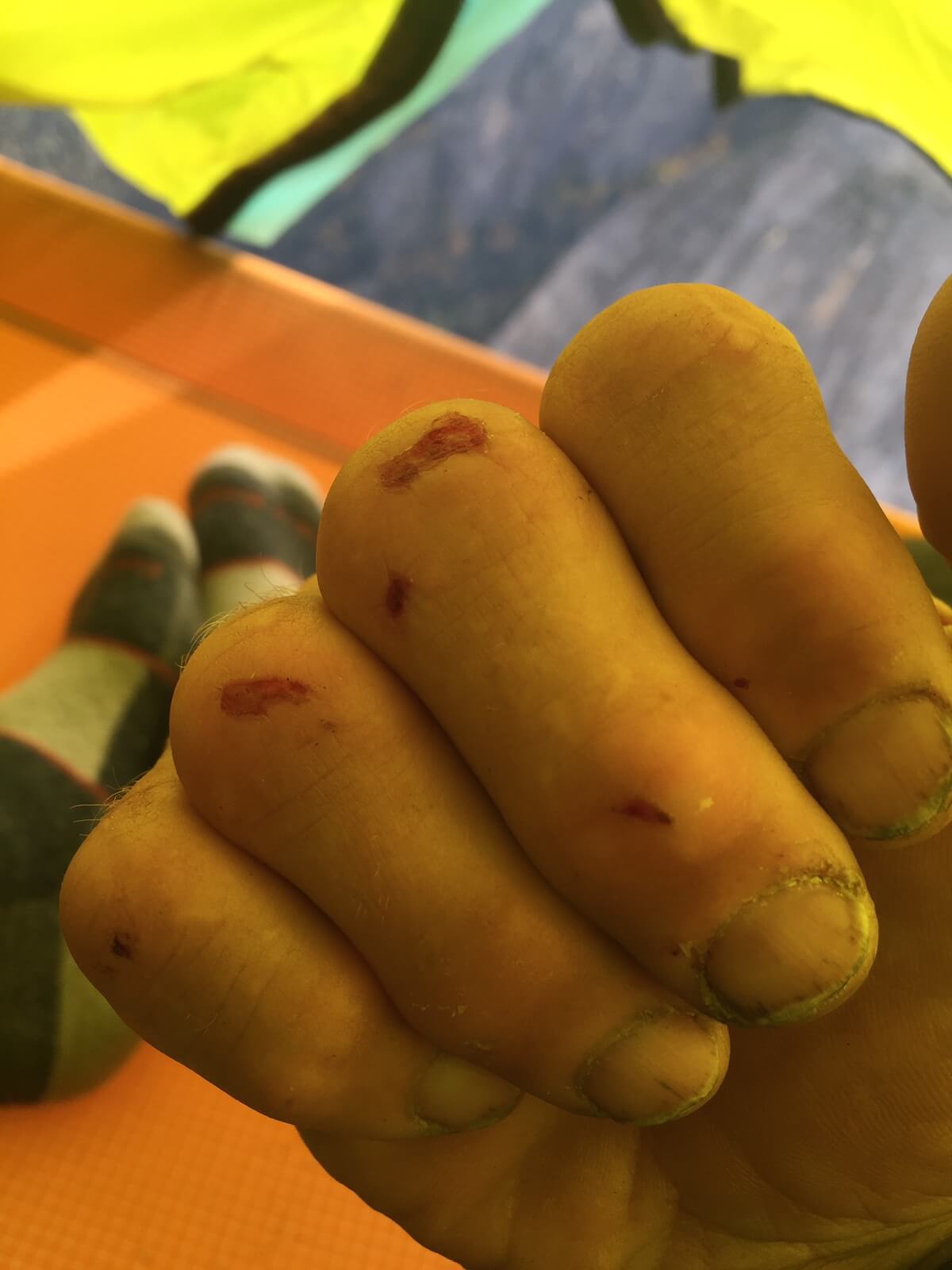
The obvious abrasions pictured above are painful but easy to distinguish from the sometimes-subtle signals the body uses to telegraph potential injury.
Serious athletes have a developed relationship to pain. Pushing into the limits of what you’re physically capable of, often feels uncomfortable. In the same way calluses develop on the outside of the body and tissues develop on the inside; your threshold for tolerating painful exertion also adapts.
But putting discomfort aside isn’t always in your best interest.
This tip is about the differences between pain and injury and offers a practical tool for navigating this sometimes-unclear relationship when you’re already doing your best to correctly interpret the body’s signals and respond responsibly.
First. any actual known tissue damage should be recognized and addressed appropriately. Bone fracture, significant inflammation, inability to bear weight or load, etc., should not be ignored.
But what do we do when there is an ache or pain without obvious tissue damage? Do we rest or do we push through it? How loud does the body have to register a complaint before it’s time to listen?
If we necessitated zero-pain as a standard before engaging in intense physical activity, we might not ever climb again. Progress would be impossible using such a standard.
The recent study on some semi-pro soccer players shows that experiencing a minor to moderate physical complaint has at least somewhat predicted a time-loss injury in the future (Whalen et all, 2019).
This suggests that we can’t ignore all signals provided by the body, but at the same time, if we stopped at the first sign of an ache or pain, we wouldn’t clip the anchors to a meaningful route at intensity or wrestle our way past a crux bouldering sequence again.
Besides, for those of us fifty years of age or more, it’s hard to recall a day that began completely pain-free.
The international Association for the Study of Pain (IASP) has recently updated their definition of pain to “an unpleasant sensory and emotional experience associated with, or resembling that associated with, actual or potential tissue damage.”
It’s important to distinguish pain from nociception. Nociception is the neural process of detecting a stimulus that is damaging or threatens damage to normal tissue. The former IASP definition of pain was “an unpleasant sensory and emotional experience associated with actual or potential tissue damage, or described in terms of such damage.”
Turns out not all pain is nociceptive pain.
Five key meanings:
If you’re still reading this, it’s likely you have some experience climbing through or training through the discomfort of a minor irritation or ache. Perhaps you modified sessions to avoid or mitigate the risk of further aggravation. Maybe a period of reduced intensity and/or duration alleviated the symptoms.
We each have an innate sense for listening to the body’s warning systems.
The following is a tool for navigating such a period when there is no obvious tissue damage, but you are experiencing pain. It’s analogous to how we approach traffic light signals while driving.
To use the traffic light analogy safely you must determine how the pain symptoms affect your performance. The green light means your pain does not affect performance at all. During the warmup the initial discomfort dissipates, and all the signals read it’s safe to move forward. You are able to perform at the desired intensity and duration without an increase in symptoms during or after climbing. This is a green light situation; you get the green light to go ahead.
The yellow light is when pain and discomfort doesn’t go away or significantly improve with activity. It’s trickier to assess because it stays at mild to moderate levels even though you can still perform at a high intensity. Maybe you need to modify the climbing session, avoiding certain terrain, movements, or positions but otherwise perform at the desired intensity and duration. Symptoms may rise slightly or linger after activity but return to pre-activity status within 24 hours. Just like a yellow light, extreme caution is necessary to proceed safely.
The red light is obvious. When you must stop or the activity has to be significantly modified, you’re not going to perform at the desired intensity or duration. Another indication of a red-light situation is when symptoms don’t return to baseline within 24 hours. Attempting to proceed in the same manner is unlikely to result in any improvements. This means stop.
Just like being a good driver on the road, awareness of changing conditions is critical to training safely on the rock or in the gym. For example, if a green light turns yellow or a yellow light turns red, it means we’re heading in the wrong direction. This is when it’s time to acknowledge that being stubborn or ignorant goes against our better instincts and interests.
The body provides a surprising amount of leeway navigating the signals, but if you’re not reading them correctly, you’re risking an accident. Taking a few weeks off from climbing will be much less of a setback to improvement than having to take a month or more.
Disclaimer: this is not a substitute for seeking professional medical advice.As with any advice around injury or rehabilitation, it’s best to seek a medical professional who specializes in the field relevant to your injury. This post is not a replacement to their knowledge and expertise. At most, it’s a distillation of what you already intuit as an experienced athlete.
Send me an email, and I'll get back to you as soon as I can.